Black birds with Yellow Beaks
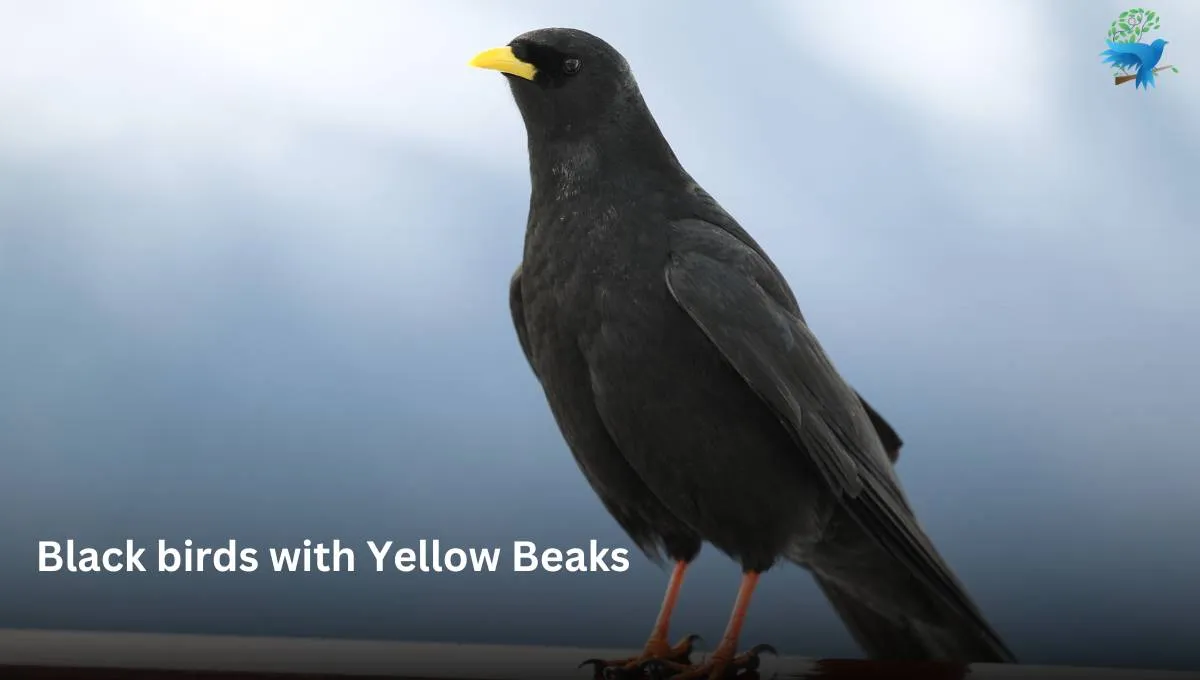
Black birds with yellow beaks are a fascinating group of avian species that captivate bird watchers and nature enthusiasts alike.
Their striking contrast of dark plumage and vibrant beaks make them a sight to behold.
Let’s dive into the world of 15 such marvelous birds, and learn where to find them, what they look like, how big they are, and what they eat.
Here is the list of 15 black birds with yellow beaks:
- Black Crake
- Yellow-billed loon
- Chinese Blackbird
- Alpine chough
- Yellow-legged thrush
- Common blackbird
- Common black hawk
- Great myna
- Toco toucan
- Black thrush
- Yellow-billed magpie
- Great hornbill
- Javan myna
- Yellow-billed nunbird
- Common starling
1. Black Crake
Black Crake, scientifically known as Zapornia flavirostra, is a waterbird in the rail and crake family, Rallidae. Its subspecies have not been reported yet.
It is a medium-sized bird, where both sexes have slaty black plumage with a slight wash of olive-brown on the wings and upperparts (generally not visible in the field).
Along with this, its beaks are bright yellow, but the irises, eye rings, legs, and feet are all red. The red feet and legs become even brighter during the breeding season.
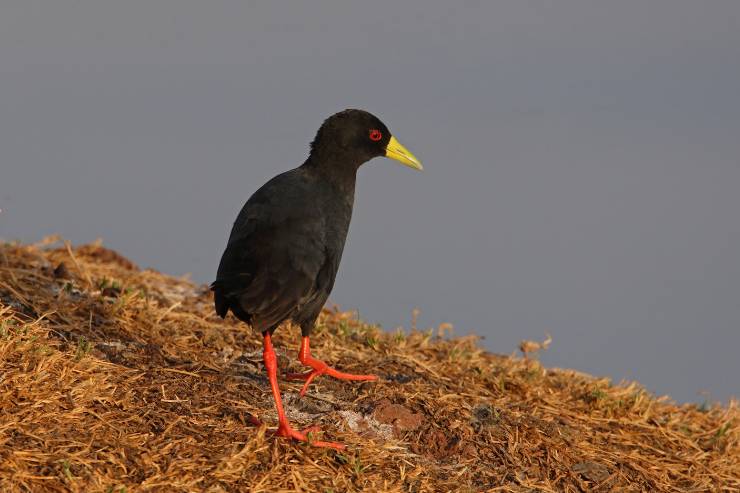
Size and Wingspan of Black Crake:
- Size: 19 to 23 cm
- Weight: 69 to 118 g
- Wingspan: 25cm
They breed in most of sub-Saharan Africa, except in very arid areas. Also, this bird frequents different types of freshwater habitats, preferring the grassy marshes of open areas and the dense undergrowth of wet clearings in wooded regions.
These birds are omnivores and eat aquatic vertebrates and invertebrates such as worms, mollusks, insects adults. Also, they eat the eggs and nestlings of herons and weavers.
2. Yellow-billed loon
Yellow-billed loon commonly known as the white-billed diver, is the largest member of the loon or diver family.
This bird’s breeding adults have a black head, white underparts, and chequered black and white mantle. While non-breeding plumage is drabber with the chin and foreneck white.
The yellow-billed loon’s main distinguishing feature is the long straw-yellow bill which, because the culmen is straight, appears slightly uptitled.
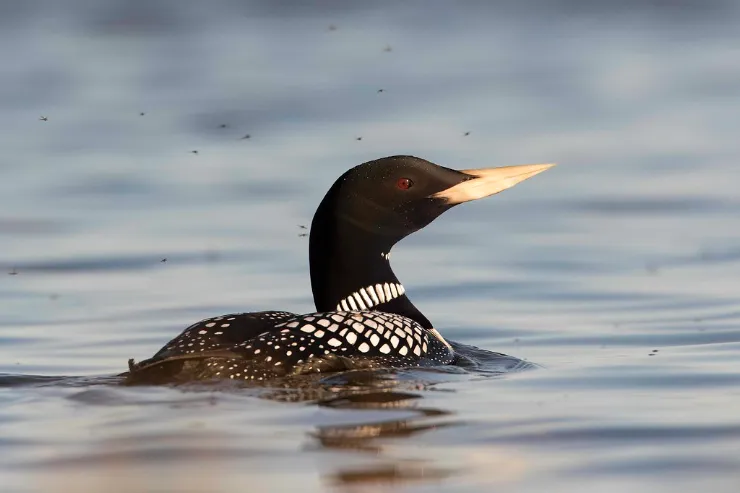
Size and wingspan of Yellow-billed loon:
- Size: 76-97cm(30-38 inches)
- Weight: 4-6.4kg(8.8 – 14.1lb)
- Wingspan: 135-160 cm(53 -63 inches)
They are found throughout northwestern Canada, Alaska, and northeastern Eurasia.
It is a specialist fish eater, catching its prey underwater. Currently, it also takes crustaceans, mollusks, and annelids, especially for its young.
3. Chinese Blackbird
Chinese blackbird is a member of the thrush family Turdidae. It was formerly considered a subspecies of the related common blackbird.
It is 28.0-29.0cm(11.0-11.4 inches) long. Only the male is sooty black above and brownish-black below, with a yellow-orange beak and eyerings.
While the female is slightly browner with a brownish beak with a bit of dull yellow at the base. Males and females both sexes have dark irises, legs, and feet.
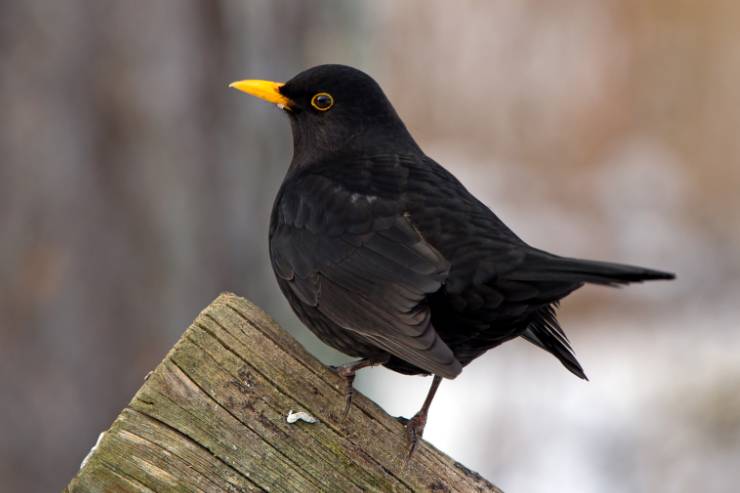
It breeds throughout much of southern, central, and eastern China. The Chinese blackbird is a partial migrant to Hong Kong and south to Laos and Vietnam.
They mainly eat invertebrates, especially earthworms and adult and larval insects. Also, it feeds seeds, berries, and fruits and occasionally catches and eats small vertebrates.
4. Alpine chough
The Alpine chough is a medium-sized member of the crow family that breeds at high altitudes. It is also known as yellow-billed chough.
It has glossy black plumage, a yellow beak, and red legs. The males and females of this species are identical in appearance, but the male averages slightly larger than the female.
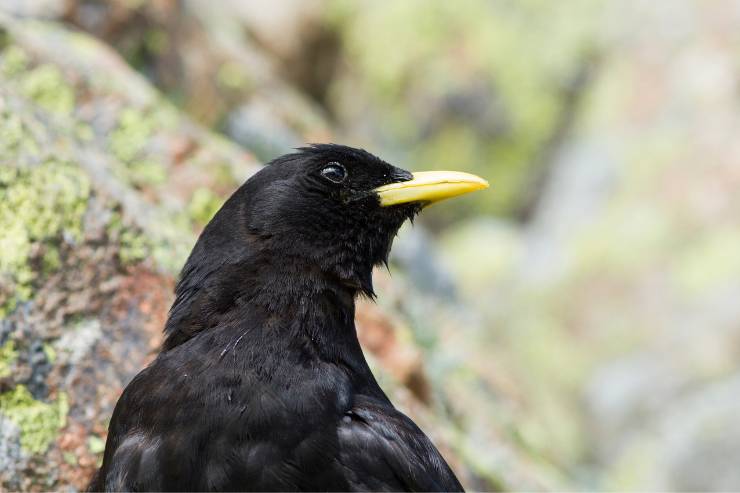
Size and Wingspan of Alpine chough:
- Size: 37-39 cm (15–15 inches)
- Weight: 188-252g
- Wingspan: 75-85 cm(30-33 inches)
This bird can live up to 23 years. Its two subspecies breed in high mountains from Spain eastwards through Southern Europe and North Africa to Central Asia and Nepal.
The breeding site is generally a cave or crevice in a cliff face. They are omnivores, so during summer, they eat mostly invertebrates called from pasture, such as beetles, snails, and grasshoppers.
However, the diet in autumn, winter, and early spring becomes mainly fruit, like berries, rose hips, and domesticated crops including apples, grapes, and pears where available.
5. Yellow-legged thrush
The yellow-legged thrush, scientifically known as Turdus flavipes, is a songbird of northern and eastern South America and the Caribbean.
Yellow-legged thrush male has a black hood, breast, tail, and wings, with slate-gray plumage, along with a yellow beak.
Whereas, the female is brown with a dull beak and also both sexes have dark irises along with yellow eyerings, feet, and legs.
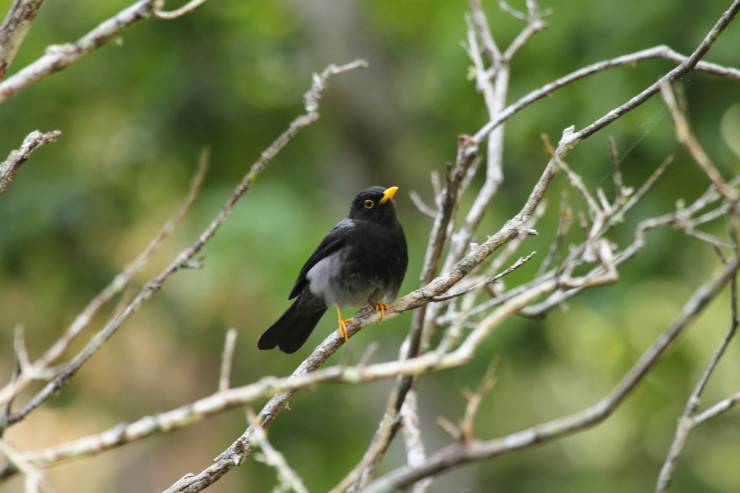
Length and weight of Yellow-legged thrush:
- Size: 22-23 cm(8.7-9.1 inches)
- Weight: 55-70g(1.9-2.5 oz)
The habitat of this bird is rainforest, secondary woodland, and overgrown plantations. It is mostly a species of highlands up to 2000m (6,600 ft) ASL, however, locally it arises down to near sea level.
This thrush mostly feeds in trees and bushes, infrequently on the ground, and mainly eats fruits and berries.
6. Common blackbird
Common blackbird also called Eurasian blackbird, is a species of true thrush. It displays sexual dimorphism, which means males and females have different appearances.
Males are black with a yellow eye-ring and an orange-yellow beak, whereas females are brown with lighter underparts.
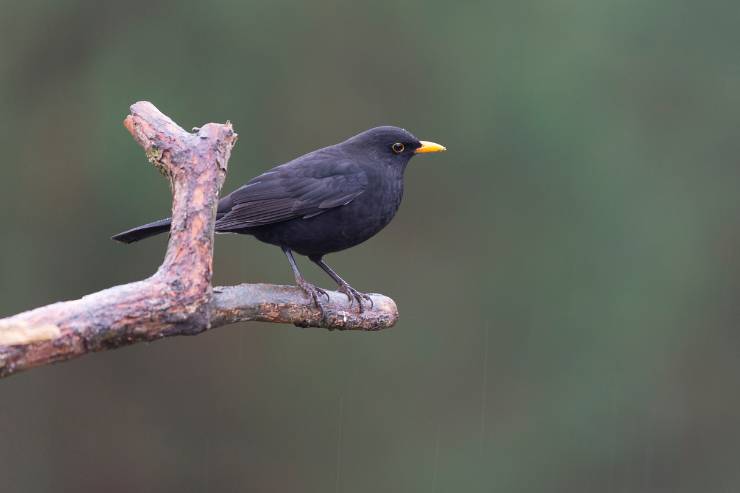
Size and wingspan of Common blackbird:
- Size: 23.5-29 cm(9.3-11.4 inches)
- Weight: 80-125 g(2.8-4.4 oz)
- Wingspan: 34-39cm
The blackbird breeds in Europe, North Africa, and Western Asia, and has been introduced to Australia and New Zealand.
It lives in very varied habitats, including mountainous regions and big city centers, where they inhabit open forests and forest edges, cultivated areas, woodlands, parks, and gardens if the cover is dense enough for hiding.
These birds are omnivores and consume a variety of insects, earthworms, seeds, and berries.
7. Great myna
The family of Sturnidae, commonly known as the white-vented myna, is the Great myna. Also, its scientific name is Acridotheres grandis.
Male and female, both sexes have black plumage with bits of white on the wings and tail and a sparse head crest. Its beak, feet, and legs are also all yellow, but the irises are reddish brown.
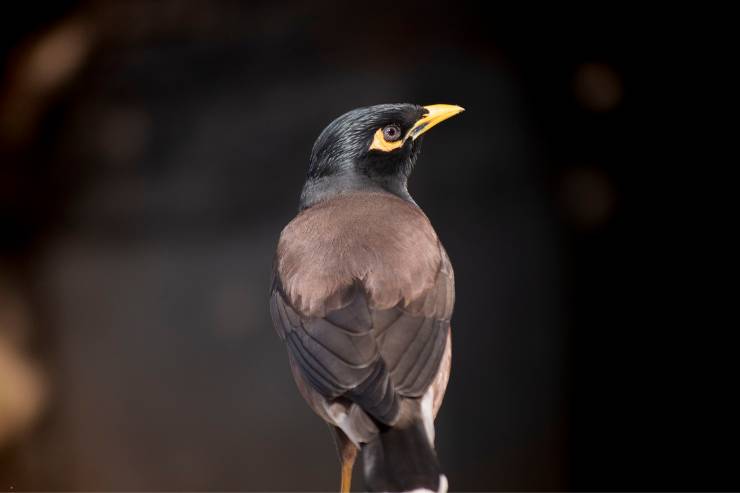
Size and weight of Great myna:
- Size: 24.5-27.5 cm(9.6-10.8 inches)
- Weight: 95-103g
The great myna is found in Nepal and Northeast India, from Bangladesh to Southeast Asia. This bird is usually seen in pairs or small groups.
They feed on insects and other small invertebrates.
8. Toco toucan
The Toco toucan is the largest and the best-known species in the toucan family. Its average lifespan is 15–20 years.
It has a distinctive appearance with a black body, a white throat, chest and upper tail coverts, and red under tail coverts.
This bird most salient feature is its massive beak, which is yellow-orange with a black base and large spot on the tip.
Also, this large bill makes up about half of their body size, which is 6.8-8.5 inches of male toucans and 6.2-8.5 inches of females.
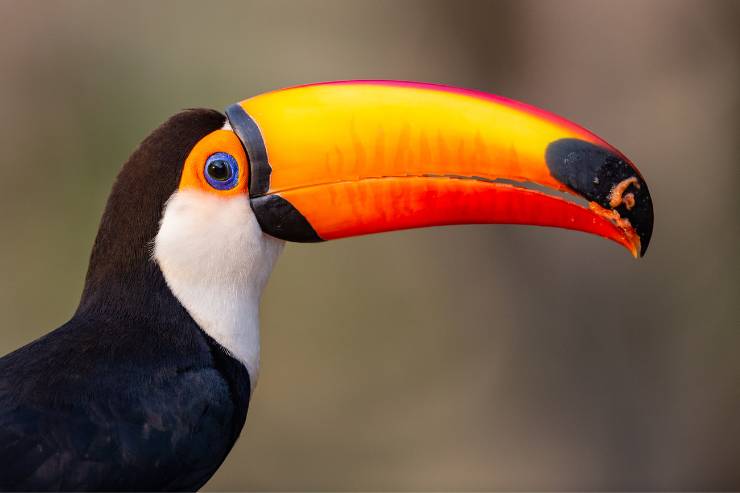
Size and weight of Toco toucan:
- Size: 56 cm (22 inches)
- Weight: 120-680 g(4–24 ounces)
The Toco toucan is endemic to South America, where it has a wide distribution from the Guianas south to northern Argentina and Uruguay.
It inhabits a variety of semi-open habitats at altitudes of up to 1,750m (5,740 feet). Also, they are common in the Brazilian cerrado, gallery forests, and the wetlands of the Pantanal.
They mainly feed on fleshy fruit, but also companion their diets with insects, eggs, and nestlings of other birds.
9. Black thrush
Black thrush, formerly known as the Black Robin, is a species of bird in the Turdidae family. They look like other blackbirds, however, they only occur in Guatemala, Mexico, El Salvador, and Honduras.
This thrush exhibits a significant gender difference. Males are all black with brown eyes and orange-yellow feathers on their legs, orbits, and bill.
While females are all brown, with gray eyes and a black beak and legs.
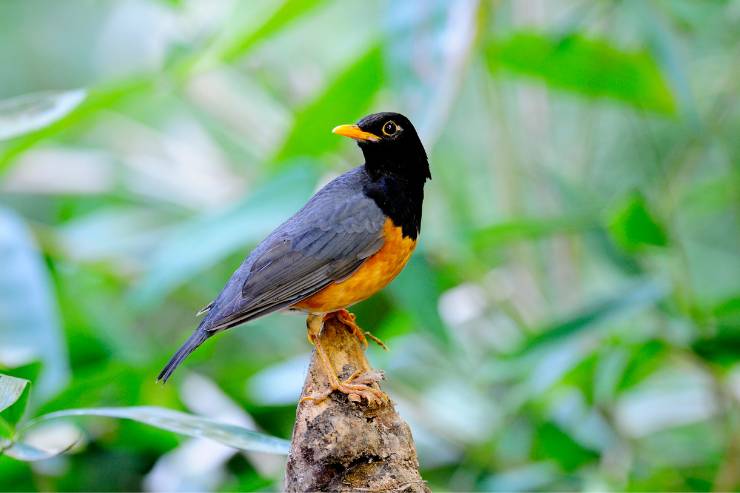
Size and wingspan of Black thrush:
- Size: 25-27 cm(9.8-10.6 inches)
- Weight: 80-100 g(2.8-3.5oz)
- Wingspan: 33-36 cm (13–14 inches)
The black thrush natural habitat is subtropical or tropical moist montane forest.
It feeds mostly in fruiting trees and bushes, frequently with other thrushes. Also, it rarely feeds on the ground.
10. Common black hawk
Common black hawk, scientific name Buteogallus anthracinus, is a bird of prey in the family Accipitridae.
The common black hawk has very broad wings and is mostly black or dark grey. Its bill is yellow with a black tip, and the legs are yellowish.
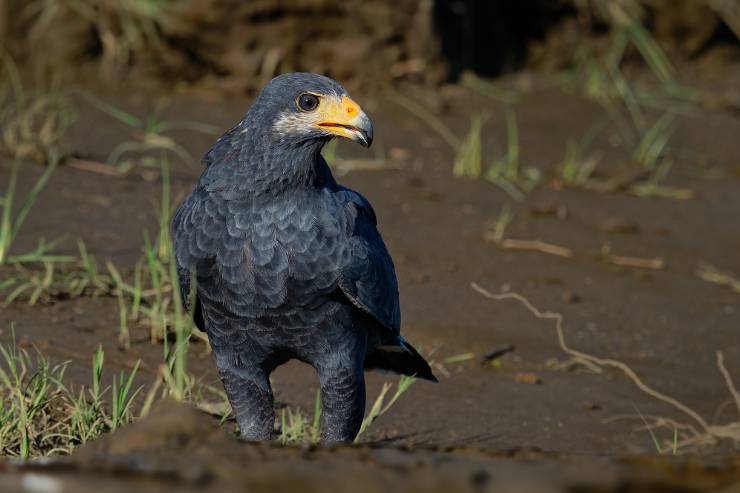
Size and wingspan of Common black hawk:
- Size: 43-53 cm (17–21 inches)
- Weight: 930g (33 oz)
- Wingspan: 127 cm (50 inches)
It is a breeding bird in the warmer parts of the Americas, from the Southwestern United States through Central America to Peru, Venezuela, and the Lesser Antilles.
This bird primarily eats crabs and crayfish, but will also take small vertebrates, eggs, and carrion. They also supplement their diet with a variety of insects.
11. Yellow-billed magpie
The yellow-billed magpie, also known as the California Magpie, is a large bird in the crow family.
This bird has a striking appearance with a black head and chest, white shoulders and belly, and iridescent blue wings.
Its most unique feature is its bright yellow bill, which gives the bird its name. Along with that, there is also a patch of bare yellow skin behind its eyes, but this is not always clearly visible.
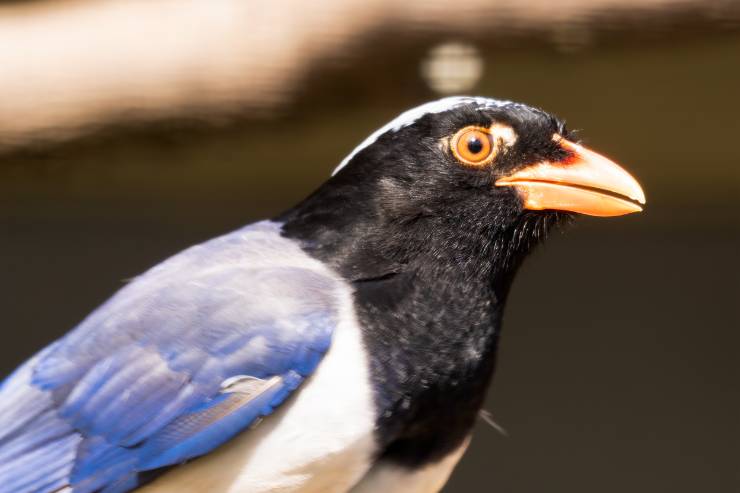
Size and wingspan of Yellow-billed magpie:
- Size: 43-53 cm (17–21 inches)
- Weight: 150-170g(5.3-6oz)
- Wingspan: 56-61 cm (22–24 inches)
The yellow-billed magpie is restricted to the US state of California. It inhabits the California Central Valley and the adjacent chaparral foothills and mountains.
It feeds on the ground, mostly eating insects, especially grasshoppers, but also eats acorns, carrion, and fruit in fall and winter.
12. Great hornbill
The great hornbill is one of the larger members of the hornbill family. This bird is known to have lived for nearly 50 years in captivity.
The most prominent feature of the hornbill is the bright yellow and black casque on top of its massive bill. The body is mostly black with a white neck, wing converts, and flight feathers.
Also, females are smaller than males and have bluish-white instead of red eyes.
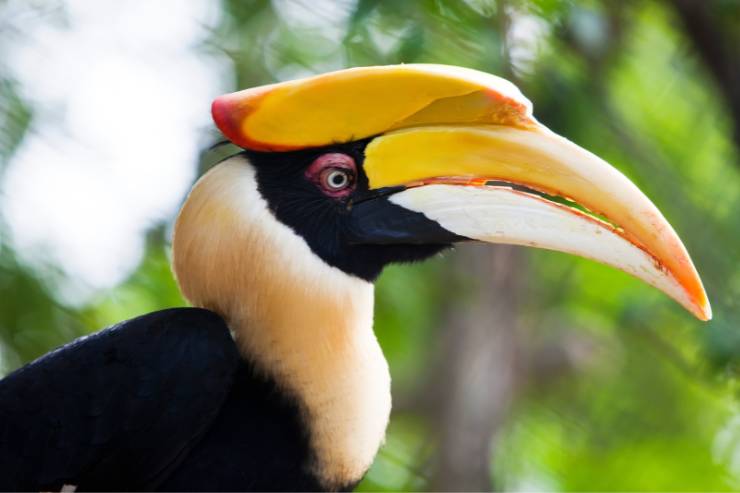
Size and wingspan of Great hornbill:
- Size: 95-130cm(37-51 inches)
- Weight: 2 to 4 kg(4.4 to 8.8lb)
- Wingspan: 152cm (60 inches)
The great hornbill is found in the Indian subcontinent and Southeast Asia. This bird inhabits moist dense old-growth (unlogged)forests in hilly regions.
Despite this, Tribal peoples hunt this bird for its various parts. The head and beaks are used in charms and the flesh is believed to be medicinal.
It is principally frugivorous but also preys on small reptiles, birds, and mammals.
13. Javan myna
Javan myna also called the white-vented myna, is a species of myna. Also, it is a member of the Starling family.
These birds are mostly black. The wings are brownish-back, and the primaries have white bases, displayed in flight as a striking white wing bar, as well as a white tail bar.
Likewise, its undertail-coverts are white, and a short crest on the forehead. The javan myna beak, legs, and feet are yellow.
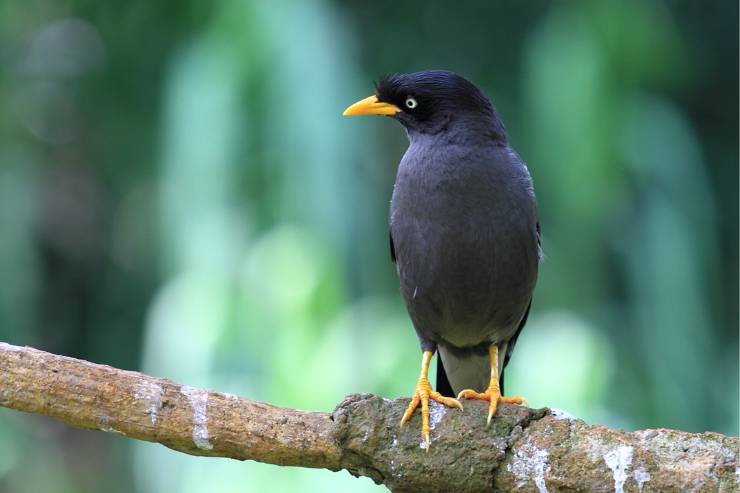
Size and wingspan of Javan myna:
- Size: 21-23 cm(8.3-9.1 inches)
- Weight: 100g(3.5oz)
- Wingspan: 39-43 cm(15.4-16.9 inches)
The myna is native to Bali and Java and has been introduced to other Asian countries, and as far away as Puerto Rico. It is also found in cities and cultivated areas.
It is omnivores and eats seeds, fruit, nectar, small insects, and human waste.
14. Yellow-billed nunbird
The yellow-billed nunbird is a songbird that belongs to the Bucconidae family. It is found in Bolivia, Brazil, Colombia, Ecuador, and Peru.
Both males and females of yellow-billed nunbird have predominantly sooty-black plumage with a very dark gray belly and green-black tail, and a bit of white on the wings.
Also, its bill is yellow and significantly shorter than those of the other members of its genus. Its feet are blackish and the eyes dark.
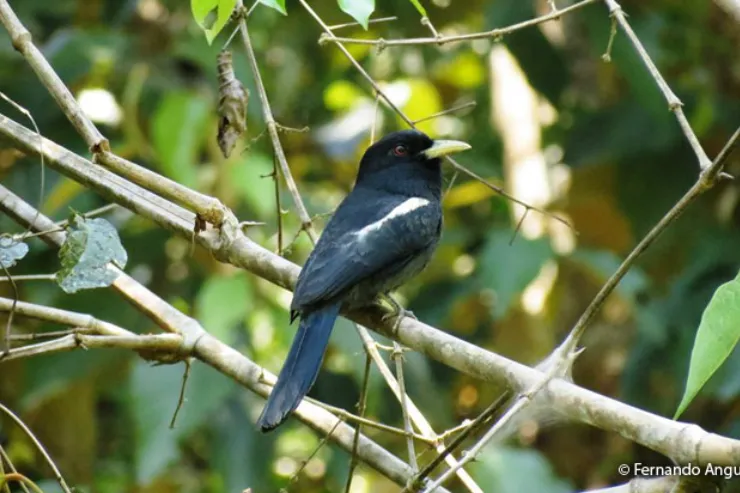
Size and weight of Yellow-billed nunbird:
- Size: 23-25cm(9.1-9.8 inches)
- Weight: 39g(1.4oz)
This bird inhabits somewhat open landscapes such as secondary forests, transitional forests, the edges of terra firme forests, and regenerating clearings with scattered trees.
Its diet hasn’t been disclosed yet. However, its diet is assumed to be mostly insects like those of other nunbirds.
15. Common starling
The common starling is a medium-sized passerine bird. It is also referred to as the European starling in North America and simply as the starling in Great Britain and Ireland.
In the summer, it has a pointed yellow beak and black iridescent plumage. While their beak turns a darker shade of yellow when winter arrives.
The common starling is a nosy bird, especially in communal roosts and other gregarious situations, with an unmusical but varied song.
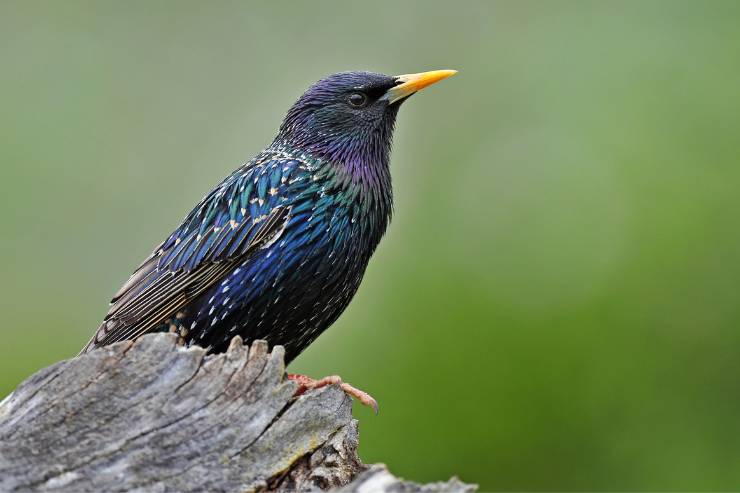
Size and wingspan of Common starling:
- Size: 19-23 cm(7.5-9.1inches)
- Weight: 58-101g(2.0-3.6oz)
- Wingspan: 31-44cm(12-17inches)
It tends to prefer open grassland or habitats with low tree and shrub cover. Throughout the breeding season, starlings will nest in cavities, such as holes in trees or other protected spaces.
They mainly eat insects. In fall and winter, they prefer to eat a wide variety of berries, fruits, and seeds.
Conclusion
These 15 black birds with yellow beaks represent just a fraction of the avian diversity!
Whether in your backyard or the wilderness, be on the lookout for these remarkable species. Each sighting is a chance to observe their unique behaviors and characteristics, adding to the richness of your bird-watching experience.
Each bird, from the Yellow-billed sunbird to the Common starling, has its unique tale, ready to unfold before your binoculars.






